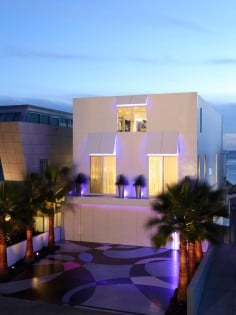
New | China's elite drawn to Malibu architect
Los Angeles-based Richard Landry is wowing high-end clients with houses boasting an open Californian sensibility or grand European style
About four years ago, a couple in Shanghai decided to build a house in the style of a French chateau and began interviewing architects in China, all of whom pulled out a copy of Richard Landry's 2006 book, , and pointed to a similar home he had completed.
"After five architects showed them the same picture, they bought the book and called me directly," said Landry. The couple flew to Los Angeles to meet him and hired him on the spot. The result is a home three years into construction, with one more to go, that Landry understatedly describes as "quite large".
Around the same time, he got a call from a businessman in Beijing, who had bought a translated copy of Landry's book at the airport.
"I didn't know the book was sold in China, or even that it was published in Chinese," said Landry.
That cold call led to Landry being retained to design a sprawling residential development in Qingdao - 40 homes of 25,000 square feet each, in 10 varying styles, incorporating French limestone, stone from Santa Barbara and slate from Vermont. The Phoenix Island residences are still under construction.
And more recently, a client in Kuala Lumpur envisaged a home with a smooth stucco finish, reminiscent of Andalusian architecture, which he had seen on a similar home in Los Angeles. So Landry sent a craftsman from Los Angeles to Malaysia, with bags of a special cement, to show local workers how to create that distinctive southern Spanish effect.
That white-glove service is one reason Los Angeles-based Landry ranks among the world's most sought-after architects for high-end residences, his homes routinely popping up in editions of and .
In recent years, Landry has been instrumental in transporting across the Pacific architectural and design ideas from Californian and European landscapes that were previously uncommon in Asia.
"[In China], we've been doing outdoor covered loggias, outdoor fireplaces and heaters built in to the ceiling, things that work with every season," said Landry.
"These features are different for our clients in that part of the world … and they are really starting to take off."
Landry says that while he has been working with clients in Indonesia, Malaysia, Singapore, Japan and India almost since founding Landry Design Group in 1987, his projects in China - primarily Shanghai, Beijing and Qingdao - began about seven years ago, in tandem with the growing ranks of the country's elite.
The uber-wealthy in China have traditionally liked to recreate the grand classical style of European villas. But Landry has also delivered stridently modernist homes, not dissimilar to his own residence in Malibu.
He likes to expose his clients in China to not just the indoor-outdoor lifestyle aesthetic popular in southern California and Mediterranean countries, but also open-plan spaces, where the kitchen flows into the dining, living and entertainment areas.
He takes into consideration cultural factors like multigenerational living (something he sees in certain cultures in the US as well), and says that no matter how modern the space, or progressive the client, the fung shui guy is always on speed dial. "Our clients come here and they see the openness of our homes, the difference in sensibility and flow, and they like that," he says.

Before that, he lived in a more traditional home in a neighbouring canyon, inspired by the barns that dotted the countryside in his native Quebec.
His current home, which he shares with his teenage daughter, is a light-flooded expanse that makes the most of technology: an app allows for glass walls in the master bedroom to frost over for privacy, or lighting to morph from electric blue to mauve to pink, depending on his mood.
There is nothing extraneous in the streamlined open-plan living/dining/kitchen space, which is striking against the backdrop of uninterrupted ocean vistas.
Many surfaces throughout the house are covered with gleaming nano glass, an import from China made of crushed glass and white marble powder fused together at high temperature for a smooth milky white stone that doesn't stain. The powder room features an avant-garde glass installation by Los Angeles-based Chinese artist Meeson Pae Yang.
"I wanted everything to flow," said Landry, who applied the same open-plan sensibility to the top floor, where the entertainment/media room and bar spills over into an extensive outdoor seating area.
"People have the misconception that all we do is big," said Landry, who has been known to work on "smaller" homes in the 4,000 sq ft range.
"But it's not about how big we can do a house. I spend as much time sweating the details on a smaller house as on a large one. It's about looking at all the opportunities a project offers, and not missing a beat."

